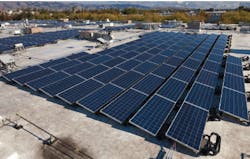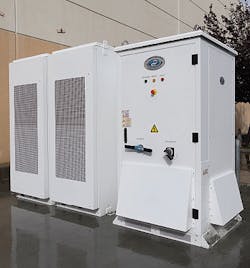Have the dark days of winter and the drab economic “recovery” got you down? Grab yourself a sunbeam. There’s plenty to go around.
The market for solar photovoltaic power equipment has been growing steadily over the past several years, well ahead of overall economic growth, a welcome exception rivaled only by LED lighting in the electrical market overall. Much of that growth has come as the costs of solar power followed a steady decline making it increasingly viable as an alternative power source. Better yet, this category is now poised for a fresh explosion of activity.
Congressional action in December to extend the investment tax credit (ITC) for renewable energy projects took many by surprise. The five-year extension, which provides a 30% federal tax credit for solar systems on residential and commercial properties, was included in the massive $1.15 trillion omnibus spending and tax bill that funds the government, signed into law just before Christmas.
Along with the steady decline in the cost of solar power, the extension of the tax credit may set the stage for the last great opportunity to get solar power on solid ground where it can survive and thrive without government incentives, say solar supporters. Solar project developers and the supply lines providing them with materials and components seem game to give it a shot.
“The tax code extension is a big point of discussion,” says Kelly Boyd, president of ElectroRep, an electrical manufacturers rep agency based in Sausalito, Calif. “Everybody is in a bullish state of mind, excited about the long term because of investment coming back into the marketplace and a sense of longer-term commitment to those investments. People are more willing to invest not only in new projects but in projects they designed but maybe shelved. Also, this growth is coming off a much stronger foundation of activity in the solar market already. We’re telling our manufacturer partners to prepare to increase production capacity.”
This surge of activity will spell opportunity for electrical manufacturers, reps, distributors and contractors. Although the solar market is well along the road to maturity in early adopter markets such as California, North Carolina, Nevada, Massachusetts, Arizona and New Jersey, the doors to this market are by no means closed to newcomers. Even in those markets there are openings, and the ITC extension, falling prices and growing awareness based on past years of sales and marketing will pull solar forward in an ever expanding assortment of new markets.
The growth of the solar market over the past few years has led to some realizations among developers that play to electrical distributors’ traditional strengths. The speed with which solar projects, particularly grid-scale photovoltaic plants, proceed to completion has highlighted the importance of an expert supply chain that can keep disruptions from happening on the ground.
The timelines for these projects have always been erratic, with requests for quotes followed by long delays, then once the permission to proceed is handed down they need everything at once. Adapting to this pattern has meant investing in inventory and constantly improving communications with distributors on the front lines for Priority Wire & Cable, Little Rock, Ark., which is both a manufacturer and master distributor that sells exclusively through distribution. Solar has produced a welcome boost of business for Priority and other wire companies, especially in the utility-scale solar market where long runs of specialty wiring are the norm.
“These projects go so fast, it’s a very short time frame before they need the material,” says Hugh Robertson, Priority Wire’s director, Renewable Energy. “Previously we would see 12 to 16 weeks of lead time, now we might have four weeks if we’re lucky. One of Priority’s approaches is to have enough inventory so that when a distributor calls and has a project where they have to have material, we’re ready to turn it around immediately. It’s a response to the new reality of their industry where they need to move quickly from the moment they get the notice to proceed. If the supplier’s deliveries are not on time that disrupts them in the field. That costs them money.”
Getting into the solar market is a significant investment, of course. Any distributor who wants a long-term presence in solar must build a specialty sales and technical support organization to focus on it. WESCO Distribution, Pittsburgh, and the CED Greentech division of Consolidated Electrical Distributors, Irving, Texas, are generally cited as the traditional electrical distributors who have done the best job of serving the solar market nationally. They both have dedicated solar specialists building relationships with solar developers in both the grid-scale and rooftop markets.
Within this highly competitive market, solar developers are increasingly aware of the value of reducing cost through supply chain innovation, a message Boyd of ElectroRep has been diligently carrying to his suppliers. Boyd says he’s been working to shift the perspective of his manufacturers to see that solar has become more of a steady flow business than the feast-or-famine dynamics of its past. “The rhythm is steadier now that there’s enough scale to build on, and they need a supply chain that’s much more structured and professional than was the case five to 10 years ago,” Boyd says.
Electrical contractors in active solar markets have embraced solar as a natural extension of their electrical work, and those who invested in the necessary expertise early are reaping benefits now. Sprig Electric, San Jose, Calif., for example, made the decision in the teeth of the Great Recession in 2009 to expand into solar and has seen healthy growth ever since, says the company’s Michael Clifton, engineering/operations manager for Sprig Electric’s Energy Efficiency Division.
“We’ve grown maybe 25% per year in solar,” Clifton says. “Solar has always been sporadic based on incentives and utility rate structures. The last 10 or so years we’ve seen nice steady growth, and it’s been fairly easy to grow. Sprig doesn’t do any advertising, no salesmen who deal with this, but just by word of mouth we’ve still had that growth.”
The spread of the solar opportunity will get a boost from the ITC on a national level, but where solar takes hold next depends heavily on local and state incentives and utility rate structures. The battles over net-metering policies by which utilities compensate homeowners and businesses with solar power generation equipment for power provided back to the grid are a hot battleground of policy that can make or break solar in a market. Nevada is getting a lesson in this right now as solar developers pack up and leave the state following a move to limit net metering there; meanwhile a new net metering policy in California has solar market mavens seeing green.
Distributors looking to get into solar might do well to steal a page from the approach used by EDGreps, a rep agency in Phoenix. Curtis Moldenhauer, outside sales account manager, says LED lighting retrofits have been a great way to open the door to solar projects. Sizing and installing a solar power system on an existing building makes a lot better return on investment when the lighting, HVAC and other systems are upgraded first to improve efficiency.
Getting into the solar market means wrapping your arms and head around a dizzying cascade of new technologies that still have a lot of advances ahead. The photovoltaic panels are the big ticket items in a solar installation, accounting typically for 70% or more of the total cost, but the pricing for commodity panels has been driven down so hard that it’s a challenge for anyone but the largest volume suppliers to make a decent margin selling them. The fundamental opportunity for electrical distributors is to focus on the balance of system (BOS) equipment that makes up the other 30%.
For contractors doing the installations, keeping their costs down means keeping the tightest possible control on the labor hours required to do the installation. This is where the innovative emphasis is gathered, with new products aimed at simplifying installation coming on the market in a constant rush.
Key parts of the BOS package are all under close scrutiny. Inverters are gaining intelligence and dropping in size, with microinverters making it possible to eliminate a lot of combiner boxes and even produce panels that output AC current. Transformers in solar projects have typically been oil-type units but dry-type transformers are gaining share because of quicker delivery, Boyd says. Fuses are now specially designed for the load and current ratings seen in solar installations. Wiring is responding to changes in UL specifications around jacket composition for UV resistance and other parameters. Racking and mounting hardware continues to get more elaborate, with sun-following intelligence and such, but sources on the ground say low cost and speed of installation remain paramount.
In the wire market, for one example, innovation to reduce costs has been the primary focus, says Robertson of Priority Wire. “It’s all guided by the drive to reduce construction costs,” he says. “We developed new string wiring harnesses, which we’re preassembling and precutting to go between the combiner boxes and modules and doing complete harness so for the installer it’s just plug and play. On feeder side, from the combiner box to the inverter, we’re always looking for ways we can reduce costs in field. Instead of sending a master reel, we can parallel positive and negative cables together and cut them into service lengths. Given accurate engineering diagrams and numbers, we can cut reel for each one of those runs, parallel it, and reduce time to install and labor.”
Amid all this componentry, there’s one that’s missing, the one that can change everything. Once the market selects and refines its best options for energy storage, the dynamics of the solar market will shift dramatically. Battery storage options are already on the market and working (see “A Contractor Steps into Onsite Storage” page 16), but the technology still has far to go before it can become a widespread solution.
Grid operators are looking to storage and demand response to address the dislocations of supply and demand and balance their systems to make better use of distributed generation resources such as rooftop solar. Only then will they be able to idle and decommission other forms of base-load generation.
So it’s counter-intuitive, but true: Even in an economy where the price of oil is in what looks like a long-term slump, funds, favorable legislation and a frenzy of activity continue to gather around an alternative solution that provides enticing growth opportunities for many companies at all levels of the electrical industry.
A Contractor’s Step into Onsite Storage
Sprig Electric, an electrical contractor based in San Jose, Calif., took a bold step recently to prove its commitment to solar power and the future of distributed generation when it teamed up with Tesla to be one of the first installations of Tesla’s Powerpack battery storage system.
The Powerpack is the commercial version of the battery-storage system (Powerwall is the residential version) being built at Tesla’s giant Gigafactory in Reno, N.V. Sprig’s installation paired the Powerpack with a 350 kW commercial rooftop photovoltaic (PV) system to optimize energy savings. The combined system will cut the building’s total energy costs by 80% to 95%, says Michael Clifton, engineering/operations manager for Sprig Electric’s Energy Efficiency Division.
The components of the system include 1,177 solar panels spread over 20,000 square feet of the building’s roof top. The 500kWh/250 kW Tesla Powerpack battery system is installed in the Sprig Electric parking lot and is connected to the grid and the PV system. In addition to five 100 kW Powerpack commercial batteries, the system includes a 250 kW inverter and a DC combiner. The footprint is approximately 10-foot x 16-foot, taking up about two parking spaces.
The Powerpack system maximizes consumption of on-site solar power, avoids peak electrical charges, and facilitates the purchase of energy when it is the cheapest. It acts as an energy storage system for grid power and the photovoltaic system, significantly increasing the utility cost savings that Sprig Electric will realize from using solar electricity alone, thus cutting utility bills by as much as 80% to 95%.
The installation at Sprig Electric headquarters is regulated by a sophisticated control system, which looks at building loads, the amount of energy the panels are producing, and the amount of power that’s stored in the battery. It then shifts power around appropriately based on those conditions.
The recently commissioned combo PV/battery storage system installed at Sprig Electric generated 6.7 MWh of energy and saved 4.94 tons of carbon dioxide in the first 8 wintery days.
“We are extremely happy at how this combo solar system has performed in its first week,” says Clifton. “We are excited to begin tracking this unique systems’ metrics and ultimately provide alternative energy solutions for our clients and partners alike. We believe the market for battery storage is really going to take off in the coming years.”
Clifton added that both rebates and tax credits are available for the battery system purchase.
About the Author
Doug Chandler
Senior Staff Writer
Doug has been reporting and writing on the electrical industry for Electrical Wholesaling and Electrical Marketing since 1992 and still finds the industry’s evolution and the characters who inhabit its companies endlessly fascinating. That was true even before e-commerce, LED lighting and distributed generation began to disrupt so many of the electrical industry’s traditional practices.
Doug earned a BA in English Literature from the University of Kansas after spending a few years in KU’s William Allen White School of Journalism, then deciding he absolutely did not want to be a journalist. In the company of his wife, two kids, two dogs and two cats, he spends a lot of time in the garden and the kitchen – growing food, cooking, brewing beer – and helping to run the family coffee shop.


